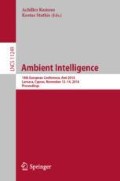Abstract
Edge computing requires the addressing of several challenges in terms of privacy, complexity, bandwidth and battery life. While in the past attempts have been made to predict users’ responsiveness to smartphone notifications, we show that this is possible with a minimal number of just three features synthesized from non-sensor based data. Our approach demonstrates that it is possible to classify user attentiveness to notifications with good accuracy, and predict response time to any type of notification within a margin of 1 min, without the need for personalized modelling.
Access this chapter
Tax calculation will be finalised at checkout
Purchases are for personal use only
References
Okoshi, T., Tsubouchi, K., Taji, M., Ichikawa, T., Tokuda, H.: Attention and engagement-awareness in the wild: a large-scale study with adaptive notifications. In: 2017 IEEE International Conference on Pervasive Computing and Communications (PerCom), pp. 100–110 (2017)
Mehrotra, A., Pejovic, V., Vermeulen, J., Hendley, R., Musolesi, M.: My phone and me: understanding people’s receptivity to mobile notifications. In: Proceedings of the 2016 CHI Conference on Human Factors in Computing Systems, pp. 1021–1032. ACM, New York (2016)
Anderson, C., Hübener, I., Seipp, A.-K., Ohly, S., David, K., Pejovic, V.: A survey of attention management systems in ubiquitous computing environments. arXiv:1806.06771 [cs] (2018)
Pielot, M., Cardoso, B., Katevas, K., Serrà, J., Matic, A., Oliver, N.: Beyond interruptibility: predicting opportune moments to engage mobile phone users. Proc. ACM Interact. Mob. Wearable Ubiquitous Technol. 1, 91:1–91:25 (2017)
Turner, L.D., Allen, S.M., Whitaker, R.M.: Reachable but not receptive: enhancing smartphone interruptibility prediction by modelling the extent of user engagement with notifications. Pervasive Mob. Comput. 40, 480–494 (2017)
Pielot, M., de Oliveira, R., Kwak, H., Oliver, N.: Didn’t you see my message?: predicting attentiveness to mobile instant messages. In: Proceedings of the SIGCHI Conference on Human Factors in Computing Systems, pp. 3319–3328. ACM, New York (2014)
Poppinga, B., Heuten, W., Boll, S.: Sensor-based identification of opportune moments for triggering notifications. IEEE Pervasive Comput. 13, 22–29 (2014)
Okoshi, T., Ramos, J., Nozaki, H., Nakazawa, J., Dey, A.K., Tokuda, H.: Attelia: reducing user’s cognitive load due to interruptive notifications on smart phones. In: 2015 IEEE International Conference on Pervasive Computing and Communications (PerCom), pp. 96–104 (2015)
Turner, L.D., Allen, S.M., Whitaker, R.M.: Push or delay? Decomposing smartphone notification response behaviour. In: Salah, A.A., Kröse, B.J.A., Cook, D.J. (eds.) HBU 2015. LNCS, vol. 9277, pp. 69–83. Springer, Cham (2015). https://doi.org/10.1007/978-3-319-24195-1_6
Mehrotra, A., Musolesi, M., Hendley, R., Pejovic, V.: Designing content-driven intelligent notification mechanisms for mobile applications. In: Proceedings of the 2015 ACM International Joint Conference on Pervasive and Ubiquitous Computing, pp. 813–824. ACM, New York (2015)
Pielot, M., Church, K., de Oliveira, R.: An in-situ study of mobile phone notifications. In: Proceedings of the 16th International Conference on Human-computer Interaction with Mobile Devices & Services, pp. 233–242. ACM, New York (2014)
Shi, W., Cao, J., Zhang, Q., Li, Y., Xu, L.: Edge computing: vision and challenges. IEEE Internet Things J. 3, 637–646 (2016)
Satyanarayanan, M.: Pervasive computing: vision and challenges. IEEE Pers. Commun. 8, 10–17 (2001)
Author information
Authors and Affiliations
Corresponding author
Editor information
Editors and Affiliations
Rights and permissions
Copyright information
© 2018 Springer Nature Switzerland AG
About this paper
Cite this paper
Komninos, A., Frengkou, E., Garofalakis, J. (2018). Predicting User Responsiveness to Smartphone Notifications for Edge Computing. In: Kameas, A., Stathis, K. (eds) Ambient Intelligence. AmI 2018. Lecture Notes in Computer Science(), vol 11249. Springer, Cham. https://doi.org/10.1007/978-3-030-03062-9_1
Download citation
DOI: https://doi.org/10.1007/978-3-030-03062-9_1
Published:
Publisher Name: Springer, Cham
Print ISBN: 978-3-030-03061-2
Online ISBN: 978-3-030-03062-9
eBook Packages: Computer ScienceComputer Science (R0)


